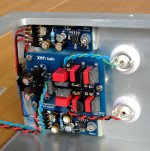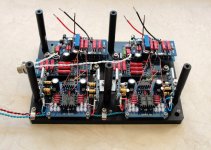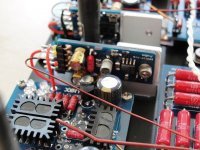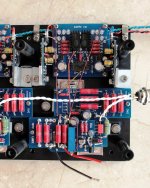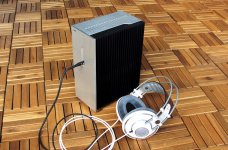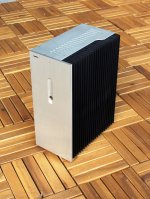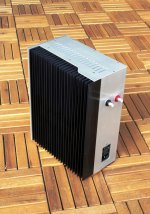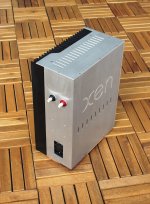Getting there slowly ........
The Didden Super Regulators were not planned.
So they are a bit too close for comfort.
But there is actually enough space available, if I would ever redo again .....
Waiting for thermal glue before power up for drift test and trimming.
Patrick
.
The Didden Super Regulators were not planned.
So they are a bit too close for comfort.
But there is actually enough space available, if I would ever redo again .....
Waiting for thermal glue before power up for drift test and trimming.
Patrick
.
Attachments
Yes, 80x200x4mm rectangular tube.
Amazingly square and straight, that no outside machining is required.
We only cleaned it with a fine cut before brushing.
The snack is, minimum order 6m (enough for 18 cases)...... 🙁
Patrick
Amazingly square and straight, that no outside machining is required.
We only cleaned it with a fine cut before brushing.
The snack is, minimum order 6m (enough for 18 cases)...... 🙁
Patrick
After some minor hiccups which cost me a day of unproductive debugging, I have first sound today.
Stupid things like a faulty trim-pot for DC adjust, and an oscillating 2SK117 source follower (would you believe!!!!!!!).
No design error.
Since then I have been listening for 4 hours, just could not stop.
Headphone is a rewired (4-wire) AK701.
Source is QA550 with XEN ES9022 45MHz module.
The DAC XO is divided by 4 to drive the QA550 (its original XO removed).
The sound is so detailed and open, and yet so liquid .....
And I just listened to a Stax SRS-2020 a week ago.
I surely am not missing the Stax.
If you want a description, then Steen's original comments years ago sums it up very well.
And I can assure you, there is no shortage of dry, tight bass with the 701.
I was initially slightly worried about drift of the TCS, as it by design does not track as well as the standard DAO.
But the heat sink is only warm to touch after an hour (30W dissipation).
And from cold to warm, the DC drifts by 50mV on both channels.
So I trim to half way. The phone will take those µW without issues.
Not worth adding a servo because of that.
Still need to make some minor wiring changes before boxing everything up.
Then the already very low background noise should improve even further.
Hopefully final pictures before end of March.
The Meier cross-feed does not really give the same imaging as listening to speakers.
I shall try the modified Linkwitz in due course. Design already done, waiting to be built.
Patrick
Stupid things like a faulty trim-pot for DC adjust, and an oscillating 2SK117 source follower (would you believe!!!!!!!).
No design error.
Since then I have been listening for 4 hours, just could not stop.
Headphone is a rewired (4-wire) AK701.
Source is QA550 with XEN ES9022 45MHz module.
The DAC XO is divided by 4 to drive the QA550 (its original XO removed).
The sound is so detailed and open, and yet so liquid .....
And I just listened to a Stax SRS-2020 a week ago.
I surely am not missing the Stax.
If you want a description, then Steen's original comments years ago sums it up very well.
And I can assure you, there is no shortage of dry, tight bass with the 701.
I was initially slightly worried about drift of the TCS, as it by design does not track as well as the standard DAO.
But the heat sink is only warm to touch after an hour (30W dissipation).
And from cold to warm, the DC drifts by 50mV on both channels.
So I trim to half way. The phone will take those µW without issues.
Not worth adding a servo because of that.
Still need to make some minor wiring changes before boxing everything up.
Then the already very low background noise should improve even further.
Hopefully final pictures before end of March.
The Meier cross-feed does not really give the same imaging as listening to speakers.
I shall try the modified Linkwitz in due course. Design already done, waiting to be built.
Patrick
This means a total of 50mV DC through the phones?
I have been taught the general rule is never to exceed 20mV
I have been taught the general rule is never to exceed 20mV
50mV through 65 ohm is less than 1mA. That in turn is less than 50µW.
If the phone will not take 50µW DC, why would you want to build a Class A amp with 400mA (5W rms) output ?
Secondly I said "So I trim to half way."
Meaning at cold start it is -25mV, after one hour it is +25mV.
You can of course always add a servo. Or just build the standard DAO.
I do not see the need. So mine stays as is.
😉
Patrick
If the phone will not take 50µW DC, why would you want to build a Class A amp with 400mA (5W rms) output ?
Secondly I said "So I trim to half way."
Meaning at cold start it is -25mV, after one hour it is +25mV.
You can of course always add a servo. Or just build the standard DAO.
I do not see the need. So mine stays as is.
😉
Patrick
I did quite a few more hours listening after returning from business trip.
I am actually more a speaker guy than a headphone guy.
But every time I switch this on, I just get hooked and simply do not want to stop.
Still waiting to try the modified Linkwitz cross feed, but even with the Meier the imaging is more natural than without.
So I think cross feed is IN for me. It is though a very personal thing, I guess.
But with cross feed on, the sound is just a touch brighter than without.
Then a "senior" member of this forum who works in professional audio development send me a link a couple of days ago.
(You just never know who is watching in the background .......)
http://www.angelfire.com/az3/dimitri/images/ew0805.pdf
And he reminded me (though I was aware of the article before) that "this circuit does not have the direct signal frequency rise ......"
Many thanks for the hint, DD. I shall definitely give it a try.
The PCB layout is already done, and I shall eventually replace VR1,2,4,5 with fixed resistors after adjustment.
Ah .... still some more work to do.
Incidentally, one of you has promised to be my Beta tester and build the same using a commercial enclosure.
The he will post here and share his building experience with you.
There will be some layout changes, but also some refinements.
(For example a John-Curl LM317 cap multiplier replaces the simple R in the CRC supply for the DAO itself.)
So stay tuned, 🙂
Patrick
I am actually more a speaker guy than a headphone guy.
But every time I switch this on, I just get hooked and simply do not want to stop.
Still waiting to try the modified Linkwitz cross feed, but even with the Meier the imaging is more natural than without.
So I think cross feed is IN for me. It is though a very personal thing, I guess.
But with cross feed on, the sound is just a touch brighter than without.
Then a "senior" member of this forum who works in professional audio development send me a link a couple of days ago.
(You just never know who is watching in the background .......)
http://www.angelfire.com/az3/dimitri/images/ew0805.pdf
And he reminded me (though I was aware of the article before) that "this circuit does not have the direct signal frequency rise ......"
Many thanks for the hint, DD. I shall definitely give it a try.
The PCB layout is already done, and I shall eventually replace VR1,2,4,5 with fixed resistors after adjustment.
Ah .... still some more work to do.
Incidentally, one of you has promised to be my Beta tester and build the same using a commercial enclosure.
The he will post here and share his building experience with you.
There will be some layout changes, but also some refinements.
(For example a John-Curl LM317 cap multiplier replaces the simple R in the CRC supply for the DAO itself.)
So stay tuned, 🙂
Patrick
So am I... 😉I'm a headphone guy
Looking forward to get an impression of the crossfeed circuits...to expand the stage in my head.
I managed to talk to WK today in the middle of his extremely busy schedule.
He will organise a completely new set of PCBs tomorrow, with all the refinements.
We have also find a very affordable commercial enclosure measuring 210x260x90mm, with two side heat sinks.
Not sure about the qualities, but we'll see.
In the end, we'll give away PCBs of all 3 cross-feed variants so that you can decide which one suits you best.
BUT Beta test first ....... One step at a time.
Patrick
He will organise a completely new set of PCBs tomorrow, with all the refinements.
We have also find a very affordable commercial enclosure measuring 210x260x90mm, with two side heat sinks.
Not sure about the qualities, but we'll see.
In the end, we'll give away PCBs of all 3 cross-feed variants so that you can decide which one suits you best.
BUT Beta test first ....... One step at a time.
Patrick
So after a difficult year in 2014, my DIY is back on track, and my personal DAO is finished.
I declare myself happy with the results.
There is to be one minor change in the TCS, due to JFET voltage ratings. Otherwise the DAO follower is great as is.
The DAO TCS on its own has a pretty flat noise spectrum at -130dBV, which is truly amazing.
(Measured using our own Ultra Low Noise Amplifier with a calibrated input noise of 2nV/sqrtHz and gain of 82dB).
The HAGS, on the other hand, is somewhat disappointing with a spectrum of -84dBV at 40Hz, falling to -95dBV at 20kHz.
On the headphone, it is a tiny hiss, like putting my head next to my loudspeaker tweeter powered by a 100W Aleph-X.
Considering that the DAO can easily output 16V pk-pk to 50 ohm at low distortion, this is not too bad.
But the cause is known, and we thing we can improved it by a factor of 10~30.
This will be verified in the Beta build, hopefully to start soon.
The sound ? Addictive.
People know that I usually do not comment on my own designs.
So you know I am truly pleased with this one. 🙂
And looking forward to testing the Danyuk cross feed before too long.
Patrick
.
I declare myself happy with the results.
There is to be one minor change in the TCS, due to JFET voltage ratings. Otherwise the DAO follower is great as is.
The DAO TCS on its own has a pretty flat noise spectrum at -130dBV, which is truly amazing.
(Measured using our own Ultra Low Noise Amplifier with a calibrated input noise of 2nV/sqrtHz and gain of 82dB).
The HAGS, on the other hand, is somewhat disappointing with a spectrum of -84dBV at 40Hz, falling to -95dBV at 20kHz.
On the headphone, it is a tiny hiss, like putting my head next to my loudspeaker tweeter powered by a 100W Aleph-X.
Considering that the DAO can easily output 16V pk-pk to 50 ohm at low distortion, this is not too bad.
But the cause is known, and we thing we can improved it by a factor of 10~30.
This will be verified in the Beta build, hopefully to start soon.
The sound ? Addictive.
People know that I usually do not comment on my own designs.
So you know I am truly pleased with this one. 🙂
And looking forward to testing the Danyuk cross feed before too long.
Patrick
.
Attachments
Nice wooden floor... aaah just joking! 😉
I'd call this the Power Brick... very nice esthetics but also full of circuits tweaked to the n-th degree.
Sooner or later I will build one 😀
I'd call this the Power Brick... very nice esthetics but also full of circuits tweaked to the n-th degree.
Sooner or later I will build one 😀
What you didn't see is the Acacia base on which the transformer is mounted, for damping out any vibration.
Though there is no vibration to damp. No mechanical noise, totally silent.
Patrick
Though there is no vibration to damp. No mechanical noise, totally silent.
Patrick
We have discussed internally within the team as to how to make this available as a public project.
There have already been a few interested parties in private communications with us.
Many thanks for your interest.
We agreed to support the project in 2 phases first :
1st phase
We shall support 10x experienced builders with complete set of PCBs and matched devices.
No individual options, else too much work for us.
These include one Beta tester up front, who has already been selected.
We reserve the right to accept or reject subscribers without giving reasons.
(This has to do with the amount of technical support we expect and can realistically provide.)
Subscribers organise their own standard components and enclosures.
The Beta tester will build based on a commercial enclosure we suggest.
So there is at least one standard layout, of which there are 3 sub-variants.
(Single custom toroidal transformer, Dual LiPo battery pack, Dual NiMH battery pack)
2nd phase (after satisfactory completion of 1st phase)
GB for PCB set open to all, without devices, or limited supply of most difficult to source devices.
We shall provide a list of alternative devices available elsewhere, some unfortunately also NOS.
(There is just no alternative for the HAGS input FETs)
Subscribers source all components on their own.
As you all know, all audio FETs are now more or less obsolete, and hence expensive.
Also the complete PCB sets consists of a total of 29 PCBs.
So it will certainly NOT win the most SQ per Dollar price.
Those who have done projects with us before will know what they get.
We estimate the total cost in the end be around 8000~10000 HKD (USD1000~1250).
And HAGS is certainly needed even for my K701 when using Cross Feed. where you lose gain.
Hope you will enjoy the project as we certainly do.
And our apologies for the years long delay.
Patrick
There have already been a few interested parties in private communications with us.
Many thanks for your interest.
We agreed to support the project in 2 phases first :
1st phase
We shall support 10x experienced builders with complete set of PCBs and matched devices.
No individual options, else too much work for us.
These include one Beta tester up front, who has already been selected.
We reserve the right to accept or reject subscribers without giving reasons.
(This has to do with the amount of technical support we expect and can realistically provide.)
Subscribers organise their own standard components and enclosures.
The Beta tester will build based on a commercial enclosure we suggest.
So there is at least one standard layout, of which there are 3 sub-variants.
(Single custom toroidal transformer, Dual LiPo battery pack, Dual NiMH battery pack)
2nd phase (after satisfactory completion of 1st phase)
GB for PCB set open to all, without devices, or limited supply of most difficult to source devices.
We shall provide a list of alternative devices available elsewhere, some unfortunately also NOS.
(There is just no alternative for the HAGS input FETs)
Subscribers source all components on their own.
As you all know, all audio FETs are now more or less obsolete, and hence expensive.
Also the complete PCB sets consists of a total of 29 PCBs.
So it will certainly NOT win the most SQ per Dollar price.
Those who have done projects with us before will know what they get.
We estimate the total cost in the end be around 8000~10000 HKD (USD1000~1250).
And HAGS is certainly needed even for my K701 when using Cross Feed. where you lose gain.
Hope you will enjoy the project as we certainly do.
And our apologies for the years long delay.
Patrick
Last edited:
- Home
- Amplifiers
- Headphone Systems
- The DAO SE all-FET Class-A ZGF Headphone Amplifier
